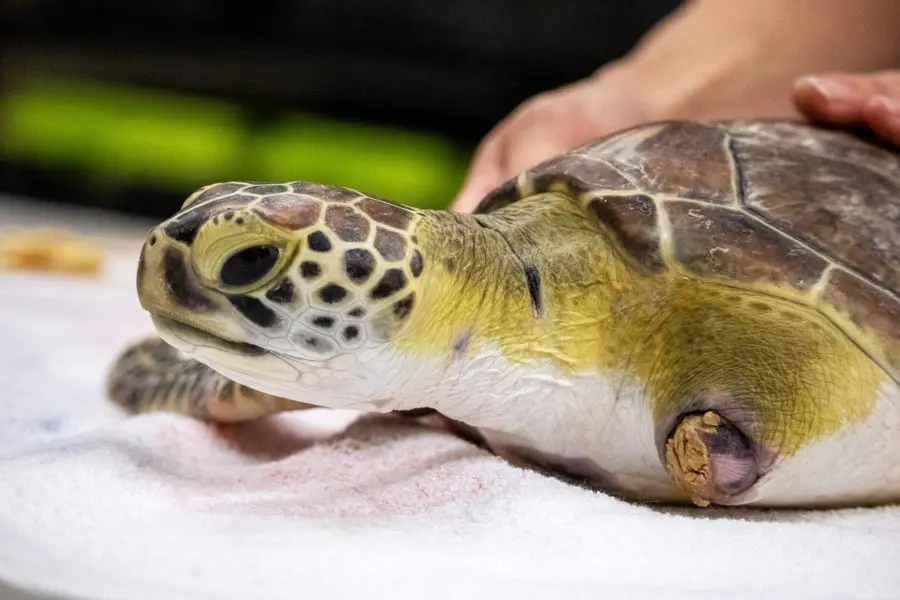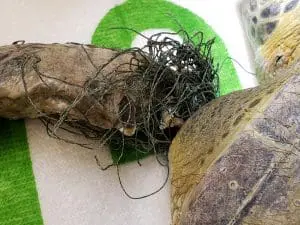

Our Sea Turtle Healing Center team is calling our newer juvenile green sea turtle patient, Gorp, one of the most resilient turtles they’ve ever met – read on to learn why!
Gorp came to our Healing Center in August after being found in Port Canaveral with fishing line wrapped around their neck, front flippers and back right flipper.

An intake photo taken of some of Gorp the green sea turtle’s injuries.
“Fishing line entanglement and ingestion is one of the worst things that a sea turtle or any wild animal can go through,” said Jess Patterson, Sea Turtle Healing Center coordinator.
“It’s painful and it’s a slow death if they can’t get help.”
The damage done to the left front flipper was so traumatic that the limb had to be amputated. Luckily, sea turtles can do very well in the ocean with only three flippers. Five-pound Gorp has a lot of growing to do as well!
“As they get older, their body is going to compensate more, and their right front flipper will become just a little bit stronger to be able to balance out their body as they swim around exploring their environment with one less flipper,” Jess said.
More concerning to our team was Gorp’s back flipper, which had areas that had begun to die off after being wrapped in fishing line. Our Healing Center team worked hard to ensure that Gorp was able to keep that flipper. A fish skin graft was applied to the area to help it heal – and although Gorp still has some scar tissue on that flipper, the limb is otherwise healthy and usable. Within a week, the necrosis had stopped.
“A lot of this is a testament to how sturdy and hardy turtles are,” Jess said. “This is one of those situations we gave Gorp the tools to heal and they took those tools and made it happen.”
In addition to giving Gorp wound care and antibiotics, we also monitored Gorp for a few weeks after their arrival to make sure this little turtle hadn’t eaten some fishing line as well. Thankfully, it appears that Gorp avoided eating the line – which would have posed a whole new set of problems.
Gorp is on their way to hopefully being released back to the ocean as they continue to receive wound care from our team. In the meantime, Gorp’s been spending a lot of their stay with us using our specially made “itchies” or objects for sea turtles to scratch their carapaces, or top shell, on.
At first, Gorp was a very picky eater, but now that Gorp is starting to feel better, the little turtle is gaining weight well.
“They’re just a pleasure to work with,” Jess said.
Gorp is a typical green sea turtle – curious about everything around them. This may be one of the reasons why our Healing Center sees so many juvenile green sea turtles who are dealing with issues after being entangled with fishing line or eating fishing line and even plastic. As opportunistic eaters, green sea turtles test out what’s food and what’s not food.
“We know that the longer that trash is out in the ocean, more bacteria grows on it and then it starts to smell like food as well,” Jess said. “So not only does trash look like food, it smells like it too. To a little green, it looks like a snack.”
We all know that we need to pick up our own trash and fishing gear and dispose of these items properly – but if you can, try to grab any trash or line you come across while at the beach, on a boat or scuba diving.
We’ve become desensitized to being told to ‘please pick up trash,’” Jess said, and we may assume the next person will grab the item – but we can’t assume.
“We all need to do our part in making sure that we’re putting the effort to removing trash and plastic on the beaches,” Jess said.
Brevard Zoo is an independent, not-for-profit organization that receives no recurring government funding for our operating costs. Your generous support enables us to continue to serve our community and continue our vital animal wellness, education and conservation programs.
